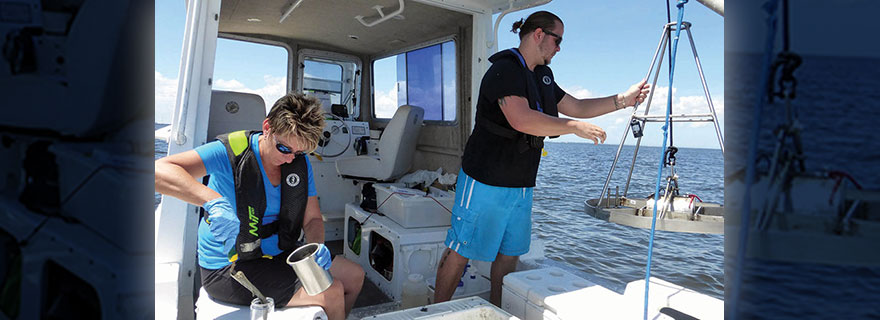20-year EPC monitoring study shows benthic index improvement
By Marcia Biggs
A heady seabreeze is blowing in from the Gulf on a steamy morning in August. After stowing a half dozen large coolers filled with ice, and boxes of sampling jars, shovels, sifters, plastic bags and gloves, a crew of three heads out into Tampa Bay. Today’s mission: to collect samples of sediment from seven sites between the Gandy Bridge and Courtney Campbell Causeway.
For one week every August, the bottom of Tampa Bay is scooped, sifted, and stored in tagged jars to be analyzed later by the scientists at the Environmental Protection Commission of Hillsborough County and other Bay area marine laboratories. A total of 64 sites are randomly selected and sampled by various agencies from three counties as part of more than two decades of research into Tampa Bay’s benthic community.
Cheers broke out when results of the 2014 seagrass survey were announced earlier this year, but less fanfare was seen when the EPC released a 20-year recap of benthic communities in Tampa Bay.
That’s a shame because benthic communities are critically important in the bay. The bay bottom provides habitat for hundreds of creatures at the base of the food web, ranging from crabs, clams, snails and worms to hundreds of other species of invertebrates. And because contaminants tend to sink into the benthic zone, which includes sand layers, rocky outcrops, soft corals and mud, trends in benthic species composition provide an important glimpse into the health of the overall water body.
The outcome of the study: Tampa Bay’s bottom-dwelling communities are generally in fair to good condition with continuing improvements, says EPC chief environmental scientist Dave Karlen, who authored the report and has been part of the study for 19 of its 20 years. As might be expected, the healthiest segments are in Lower and Middle Tampa Bay — areas with the least human impacts. The most degraded segment was Hillsborough Bay.
In the study, random samples were collected at 1,572 sites as part of a tri-county effort under the direction of the EPC that began in 1993 as a monitoring program initiative of the Tampa Bay Estuary Program.
“Baywide, we’ve seen improvement in the benthic index which is an overall summary of all species,” said Karlen. “Animal species are abundant indicators of cleaner water habitats.”
The sampling data monitored:
- Animal communities (composition and diversity, dominant species and distribution, environmental indicators, benthic index)
- Sediment composition (silt, clay)
- Sediment contaminants (heavy metals, PCB, PAH, pesticides, etc.)
- Salinity, oxygen and pH levels
Levels of oxygen and contaminants are of keen concern to the Bay’s bottom dwellers. These and other stressors such as changes in salinity and temperature can determine which benthic species can survive in a given area. By measuring the abundance and diversity of these benthic organisms and testing for the presence of sediment contaminants, ecological changes in the bay can be effectively monitored.
“An important indicator of Tampa Bay’s health is the degree of low dissolved oxygen, or hypoxia,” said Karlen. “Low oxygen suffocates organisms. Some may be able to survive, so we look at the dominant species that are surviving in various conditions. Typically Hillsborough Bay has suffered from issues with hypoxia.”
Contaminants, some highly toxic, typically found in Tampa Bay include arsenic, cadmium, copper, chromium, lead and zinc. Analyzing sediment composition is integral to determining the level of these pollutants. “Silt sediments generally tend to accumulate contaminants like heavy metals,” said Karlen. “The study shows that the vast majority of the bay is fairly clean, though thresholds vary depending on location. Most of the higher levels (of toxic contaminants) are in MacKay and Hillsborough bays.”
Study findings
Rating the health of the Tampa Bay benthic community using the Tampa Bay Benthic Index and the EPA’s National Coastal Assessment program criteria, Tampa Bay as a whole rated as “Fair.” Middle and Lower Tampa Bay segments rated “Good” (over 50% of Tampa Bay’s surface area), Old Tampa Bay rated “Fair” while Hillsborough Bay, Boca Ciega Bay, Terra Ceia Bay and the Manatee River rated “Poor.”
Karlen is not disappointed with this assessment because the EPA has very stringent criteria. “Over 50% of the bay is considered fair, and you can see index scores were quite low during the early years. The overall trend is an increase in the benthic index, which is a good thing.”
- The majority of Tampa Bay sediments were not found to have high levels of contaminants. Sites with high contaminant levels were predominantly located in Hillsborough Bay.
- The metal cadmium had moderately high concentrations in 42% of the samples, but most were not considered to be above natural background levels. Cadmium is a natural byproduct of phosphate.
- Over 1,500 animal species were identified.
- In the benthic index, Hillsborough Bay had the most degraded and empty (no species) samples. Lower Tampa Bay had the most healthy samples, followed by Middle Tampa Bay.
“Long-term monitoring programs, like the one conducted by EPC’s benthic group, are instrumental for the bay’s resource management community,” said Ed Sherwood, TBEP’s senior scientist. “Without these data, we wouldn’t know where to focus our restoration efforts in the future.”
Learn more about benthos with a fun look at “Marvelous Mud” from the Spring 2012 issue of Bay Soundings.
